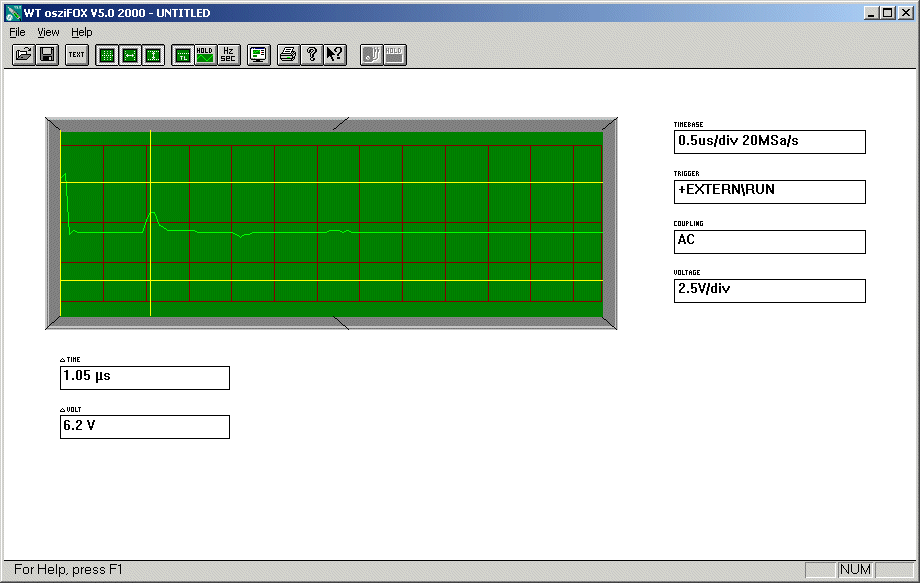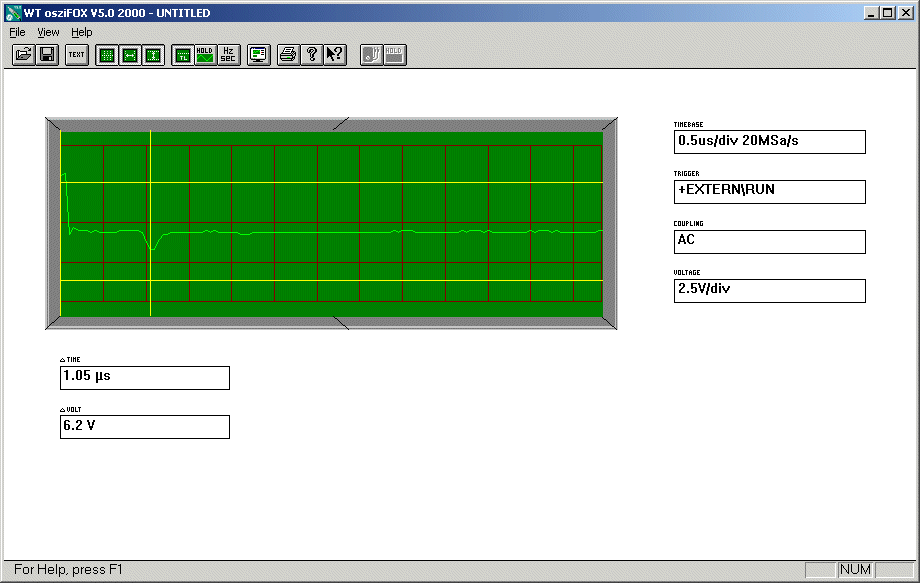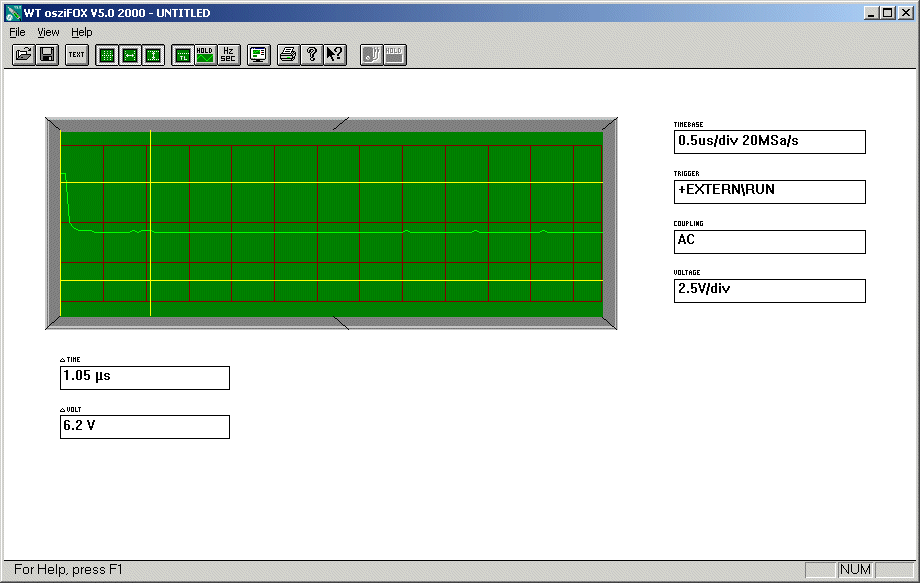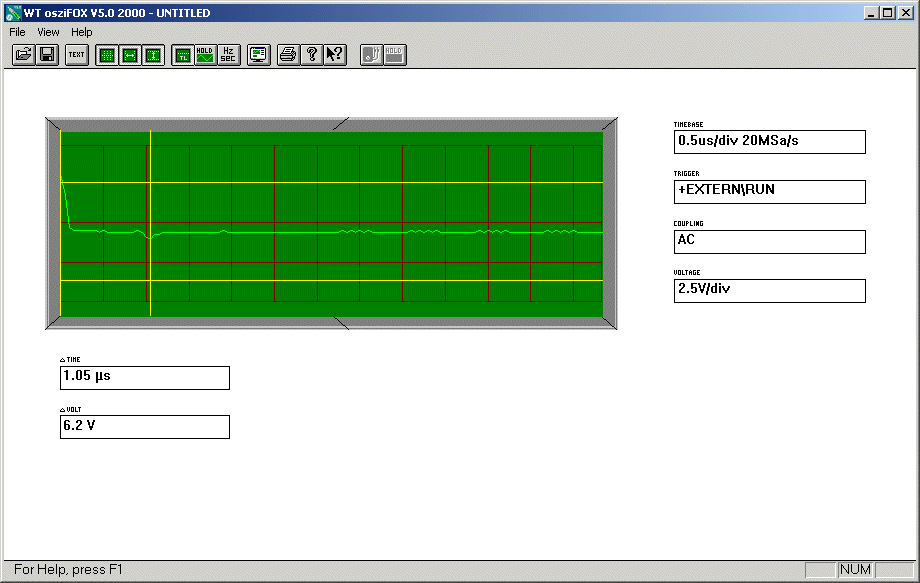The following tests are performed with 100 meter long CAT5e twisted pair cable. This cable has 100 ohm impedance. One pair of wires is used for testing (wire pair that is connected to RJ-45 connector pins 4 and 5). The signal source is the TDR signal source described at http://www.epanorama.net/circuits/tdr.html. Waveforms are measured with osziFOX handheld oscilloscope.
On the left of the oscilloscope picture you see the pulse sent by the TDR signal source. The reflection from the other end of the cable can be seen after it at the location marked with yeallow marker.




If you have learned transmission-line theory during a few lectures in an electromagnetic-fields class, then you learned transmission-line theory with wave equations and a lot of difficult math. Usually it is not much point in trying to work with those equations. With an understanding of the underlying physics, you can often go a lot further in analyzing transmission lines than you can by manipulating dozens of complex equations.
A transmission line is a set of conductors used for transmitting electrical signals. In most discussions of transmission-line theory is the assumption that the lines are uniform.
A uniform transmission line is one whose geometry and materials are uniform. That is, the conductor shape, size, and spacing are constant, and the electrical characteristics of the conductors and the material between them are uniform. Some examples of uniform transmission lines are coaxial cables, twisted-wire pairs, and parallel-wire pairs.
The transmission line, which effectively acts as a transmission medium, guides the signal along the way. The signal travels through this medium at the speed of light within that medium. The speed on the polyethylene insulated RG-59 coaxial cable is for example 66% os the speed of light. For example normal Category 5 cable propagation speed is 66% the speed of light, and for most coaxial cables this value is between 66% and 86%.
You have two models for a transmission line: a circuit comprising infinitesimal inductances and capacitances with parameters L and C and a waveguide for signals with parameters signal speed and characteristic impedance. Although these models are interchangeable, the waveguide model is usually more useful for transmission-line analysis.
Whenever an electromagnetic wave encounters a change in impedance (impedance boundary), some of the signal is transmitted and some of the signal is reflected. The difference between the impedances determines the amplitude of the reflected and transmitted waves. The reflection coefficient, , for the voltage wave is
P=VREFLECTED/VINCIDENT=(Z2-Z1)/(Z2+Z1)
whereas the transmission coefficient is
T=VTRANSMITTED/VINCIDENT =1+p
Amount of reflection is independent of frequency and occurs at all frequencies. You've probably heard or read that transmission-line effects become apparent at higher frequencies, but rarely does anyone explain why. The transmission-line effects (overshoot and oscillation) become apparent when the rise time, tRISE, is short compared with the transmission-line delay, t. When the signal rise time becomes much longer than the transmission-line delay (t), the reflections get "lost" in the transition region. The effect of the reflections then becomes negligible.
A signal traveling along a transmission line has voltage and current waves related by the characteristic impedance of the line. Signal reflections occur at impedance boundaries. As it travels down the line, a signal has delay associated with it.
Transmission-line effects:
If we send a pulse (any step function) to a line, this wave travels down the cable and reaches the load at time determined by the cable length and signal speed in the cable. Let's call this time t.
If the cable's characteristic impedance is different from the impedance of the load, some of the incident wave transmits to the load, and some is reflected by the load. The reflected wave travels back through the cable and arrives back at the source at time 2t. If the source impedance does not match the characteristic impedance of the cable, another reflection occurs so that source load absorbs some of the wave, and some is reflected. Subsequent waves arrive at the load in this manner ad infinitum, decreasing in amplitude after each round trip. A simple step signal at the source ends up producing a step wave followed by a series of oscillations at the load (and also seen at source end as well).
Cables used to carry high frequency electrical signals are generally analysed as a form of Transmission Line. The amount of capacitance/metre and inductance/metre depends mainly upon the size and shape of the conductors. The Characteristic Impedance depends upon the ratio of the values of the capacitance per metre and inductance per metre. To understand its meaning, consider a very long run of cable that stretches away towards infinity from a signal source. The result, when the signal power vanishes, never to be seen again, is that the cable behaves like a resistive load of an effective resistance set by the cable itself. This value is called the Characteristic Impedance, of the cable.
Return loss (RL) is a measure of the reflected energy caused by impedance mismatches in the cabling system. Return loss is an important characteristic for any transmission line because it may be responsible for a significant noise component that hinders the ability of the receiver when the data is extracted from the signal. It directly affects "jitter." Return loss is one number which shows cable performance meaning how well it matches the nominal impedance. Poor cable return loss can show cable manufacturing defects and installation defects (cable damaged on installation). With a good quality coaxial cable in good condition you generally get better than -30 dB return loss, and you should generally not got much worse than -20 dB.
Opens, shorts or less-severe impedance discontinuities have a way of showing up on cables in strange places - places you might never suspect. These can occur on coaxial transmission lines or twisted-pair lines. Such opens, shorts or other impedance discontinuities are called faults. The location of faults cannot be determined with simple ohmmeters. Even the existence of certain faults cannot be determined with an ohmmeter. Time domain reflectomer is an instrument often used ot locate such faults. You can use Time Domain Reflectometry to look at the characteristic impedance along the entire length of the cable.
Time Domain Reflectometry measurements (sometimes called Time Domain Spectroscopy techniques) work by injecting a short duration fast rise time pulse into the cable under test. The effect on the cable is measured with an oscilloscope. In a TDR system, a pulse generator injects a fast-rising pulse into a transmission line (usually coaxial cable). The pulse travels the length of the cable, bounces off the far end, and returns through the cable for display on an oscilloscope. Commercial Time Domain Reflectometers incorporate a pulser and scope in a single unit, but in a pinch you can easily put together your own TDR using a pulse generator, scope, and a splitter
The injected pulse radiates down the cable and at the point where the cable ends some portion of the signal pulse is reflected back to the injection point. The amount of the reflected energy is a function of the condition at the end of the cable. In addition to the amount of energy, you can analyze the the reflected signal waveform and timing details to get information on what kind of impedance mismatches can be seen on the cable and where they are located in the cable.
Also any change in the cable impedance due to a connection, major kink or other problem will generate a reflection in addition to the reflection from the end of the cable. By timing the delay between the original pulse and the reflection it is possible to discern the point on the cable length where an anomaly exists. The cable type governs this signal propagation speed, that number can be used to convert the time to cable lehngt. For example normal Category 5 cable propagation speed is 66% the speed of light, and for most coaxial cables this value is between 66% and 86%. Remeber then doing calculations that the time displayed on oscilloscope is twice the cable length, since the signal goes through the cable twice, to the far end and back to the oscilloscope. Commercial TDR units are often calibrated in footage or meters so you don't need to do a conversion from time to distance.
You can get some idea of how severe impedance mismatch happens by looking at the signal amplitude. The more impedance mismatch, more relected energy and thus higher amplitude reflected signal. Usually it is hard to make any accurate judgements on the reflected signal amplitude, because typically the cable attenuation causes lots of signal attenuation. So more far away the impedance mismatch is, the weaker the signal gets before you see it. If you know the cable attenuation characteristics or have some value to compare the signal amplitude (some other known impedance mismatch on same cable nearby what you are measuring), then you might try to make some educated quess how severe the problem is. When thinking of the signal attenuation on the cable, please note that since the signal goes through the cable twice, to the far end and back to the oscilloscope, you need to count the cable attenuation twice.
Two types of stimulus pulses are commonly used for TDR; impulse, and step-voltage.
The TDR circuit presented in this article is designed for impulse type measurements in mind. This is easier and adequate for many uses. The waveforms generatred by impulse type signal source are easier to "read".
The circuit can be used also for step-voltage system measurements by selecting the longest pulse lenght that the circuit generates and use the start of that pulse as the step signal.
The TDR waveform shows the effect of all the reflections created by all of the impedance discontinuities. The waveform is like a road map of the impedance variations across the transmission line. The waveform can be evaluated to determine how much the impedance deviates from the nominal value.
Different TDR systems have different performacne characteristics. Several factors affect a TDR system's ability to resolve closely-spaced discontinuities. If a TDR system has insufficient resolution, small or closely-spaced discontinuities may be smoothed together into a single aberration in the waveform. This effect may not only obscure some discontinuities, but it also may lead to inaccurate impedance readings.
Rise time, settling time and pulse aberrations of the stimulus can also significantly affect a TDR system's resolution. Two neighboring discontinuities may be indistinguishable to the measurement instrument if the distance between them amounts to less than half the system rise time. While in many cases the fastest rise time available is desirable, very fast rise times can, in some cases, give misleading results on a TDR measurement. Aberrations that occur prior to the main incident step can be particularly troublesome because they arrive at a discontinuity and begin generating reflections before the main step arrives. These early reflections reduce resolution by obscuring closely-spaced discontinuities. Aberrations, such as ringing, that occur after the incident step will cause corresponding aberrations in the reflections. These aberrations will be difficult to distinguish from the reflections caused by discontinuities in the device-under-test (DUT).
Many factors contribute to the accuracy of a TDR measurement. These include the TDR system.s step response, interconnect reflections and DUT losses, step amplitude accuracy, baseline correction and the accuracy of the reference impedance (ZO) used in the measurements. All TDR measurements are relative; they are made by comparing reflected amplitudes to an incident amplitude.
Random noise can be a significant source of error when making measurements of small impedance variations.
Cable losses in the test setup can cause several problems. While both conductor loss and dielectric loss can occur, conductor loss usually dominates. Conductor loss is caused by the finite resistance of the metal conductors in the cable which, due to the skin effect, increases with frequency. The result of this incremental series resistance is an apparent increase in impedance as you look further into the cable. So, with long test cables, the DUT impedance looks higher than it actually is. The second problem is that the rise time and settling of the incident pulse is degraded by the time it reaches the end of the cable. This affects resolution and accuracy since the effective amplitude of the incident step is different than expected.
You need a fast oscilloscope to get nice measurement results from the TDR measurements. Generally the faster the better. I have made some basic measurements with 20 MHz analogue oscilloscope and 20 megasamples per second digital samplign oscilloscope (osziFox). With such equipment, the measurement accuracy is limited to few meters at the best. You can get information if something is terribly wrong and where is the problem. And you can measure length of long cables (tens of meters with accuracy of few meters). But using such oscilloscpe will not show you all the fine details of the wiring.
If you have access to oscilloscope with 100 MHz or 1 GHz sample rate, you can get much more accurate measurements. When usign such high bandwidth expensive oscilloscope, you need to be very careful with it. High-bandwidth sampling heads are often extremely static-sensitive. To ensure their continued performance in impedance and signal integrity applications, they require protection devices above and beyond those which suffice for conventional oscilloscopes. You should cap sampling inputs when not in use, use grounded wrist straps when workign with device and always discharge the device being measured before probing or connecting it to the module (touching the probe ground lead to the point you want to TDR test). It is a good idea to connect DUT cable wires to ground before making any measurements. In case your oscilloscope is a high frequency scope with 50 ohm input impedance, I recommend to consider using 1 kohm resistive probe for making measurements.
Nowadays many high-speed designs are implemented with differential transmission lines. Differential transmission lines are used for example to carry Ethernet signals (UTP cable) and also to carry telecom signals (PSTN, ADSL, T1 etc..).
All of the single-ended TDR measurement concepts discussed so far also apply to differential transmission lines. However, they must be extended to provide useful measurements of differential impedance.
A differential transmission line has two unique modes of propagation, each with its own characteristic impedance and propagation velocity. Much of the literature refers to these as the odd mode and the even mode.
Tying together the two conductors in a differential line and driving them with a traditional single-ended TDR system, will yield a good measure of common mode impedance.
To provide true differential impedance measurements, you would need a signal source that can give two polarity-selectable TDR step for each of two channels. With this approach, the differential system can actually be driven differentially. You need also differential input module for oscilloscope to measure the differential signals on the cable. True differential TDR measurements require that both the stimulus and the acquisition systems be well matched in terms of timing and step response. Poor matching between the cables or interconnect devices and the DUT will skew the TDR steps in time when they arrive at the DUT, even if they are aligned at the instrument.s front panel, causing significant measurement error.
Signal integrity is an issue that grows more important with each |successive advancement in system clock and data rates. A key predictor for signal integrity is the impedance of the environment. cables, connectors, package leads, and circuit board traces - through which signals must travel. Consequently, impedance measurements have become part of almost every high-speed design project.
Time Domain Reflectometry is a convenient, powerful tool for characterizing impedance of single-ended and differential transmission lines and networks. A TDR instrument takes advantage of the fact that any change in impedance in a transmission line or network causes reflections that are a function of magnitude of the discontinuity.
There are ,modern commercial TDR-capable instruments that can automatically compare the incident and reflected amplitudes to provide a direct readout of impedance, reflection coefficient and time for both common mode and differential impedance. In addition, some of them have waveform math functions built into the instrument to automatically display TDR results for a user-selected rise time.